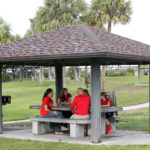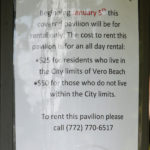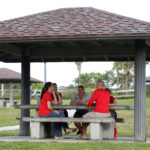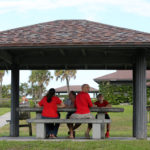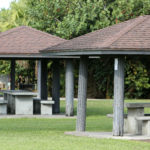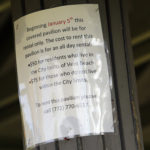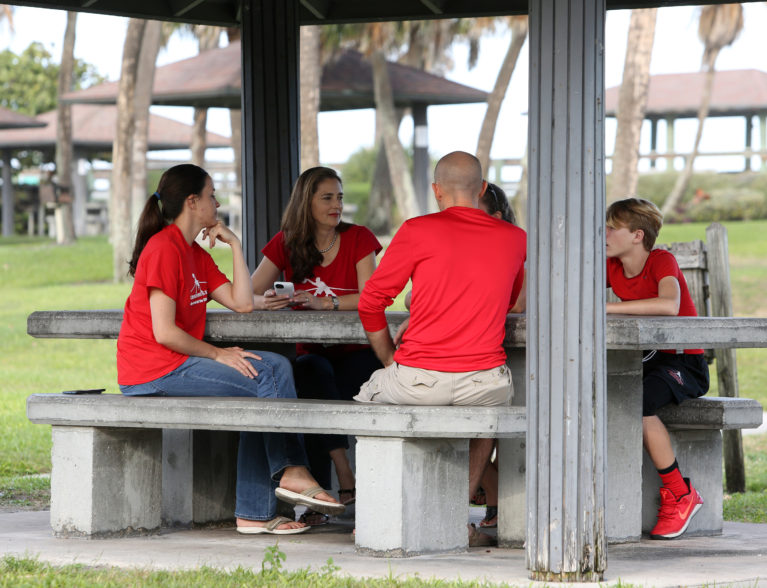
Photo by Leigh Green
When I want to show off Vero Beach and impress visitors with the beauty and charm of my adopted hometown, I take them to the picturesque places that justify calling it “our seaside slice of heaven.”
Those places include Riverside Park, the Conn Beach boardwalk and the city’s three beach parks, all of which are among the most picturesque stops on any tour of our community.
They’re also a big part of our small-town, coastal quality of life – something on which we can’t put a price.
The Vero Beach City Council, however, wants to try.
Starting Jan. 1, the city will allow people to reserve and rent the covered pavilions at Jaycee, Humiston and South Beach parks, charging non-residents more to do so.
And that’s just the beginning: Recreation Director Rob Slezak said the city likely will do the same at other parks, including Riverside and MacWilliam parks, especially if the reservation system is well-received by the community.
“The Recreation Department is being asked to pay for itself,” Slezak said of the new rental and higher-fee policies, which eventually will extend to all – or at least most – of the city’s parks and recreation facilities.
It was two years ago that a then-new City Council told Slezak to explore ways his department could generate revenues to help cover the costs of maintaining and operating its facilities.
The reason?
“Recreation was bleeding money,” Mayor Harry Howle said. “We spend more than $500,000 a year just to maintain our parks and recreation facilities, and we needed to do something to offset the costs.
“Rather than put that cost solely on the city taxpayers,” he added, “we want to see if we can generate revenue by charging for or, in some cases, raising fees to use our facilities.”
The concept of monetizing recreation came to a head last summer, when the city considered leasing its money-losing Riverhouse at MacWilliam Park to Orchid Island Brewery owner Alden Bing.
The Recreation Commission refused to recommend the plan to the City Council, and the controversy convinced Bing to withdraw his proposal to move his brewery to the park. Instead, the city continues to rent a recently renovated Riverhouse, which was damaged by Hurricane Irma in 2017, for private functions.
But the facility continues to operate at a loss, as do most of the Recreation Department’s offerings.
That’s not surprising, nor is it necessarily a bad thing, given how much parks and recreational amenities enhance a community’s quality of life.
It’s the price of being a special place to live.
More than a few of my realtor friends have told me they often drive through Riverside Park, past Memorial Island, the Riverside Theater and Vero Beach Museum of Art, when working with prospective homebuyers, particularly those from out of town who are not familiar with Vero Beach.
They’ll also cruise along Ocean Drive, sure to point out the easy access to our free-of-charge beach parks.
Fact is, Vero’s parks and other recreational amenities benefit the entire community, including those who live outside the city – especially those who live in the unincorporated parts of the county.
According to Slezak, more than two-thirds of the people who visit Vero Beach’s parks and utilize the city’s recreational facilities are not city residents. Yet, the costs of operating and maintaining those parks and facilities have been borne solely by city taxpayers.
“City residents are paying for these amenities, which are used mostly by county residents,” Slezak said. “For a long time, the thinking was always: People coming into the city to use these facilities will spend money here and pump money back into the city.
“Besides, recreation has always been a quality-of-life thing,” he added. “It’s something good for the city.”
But not only the city.
So I asked Slezak: With so many county residents also enjoying the perks of Vero Beach’s parks, shouldn’t the county contribute something to cover the city’s costs?
He laughed.
“Oh, it comes up, but the conversation never gets very far,” Slezak said. “You can understand why.”
The county has 27 of its own parks, including 10 on the island, to operate and maintain, as well as boat launches, docks, ball fields and the fairgrounds.
Certainly, the city could use a larger share of the county’s tourist tax revenue, which Councilwoman Laura Moss continues to push for and might someday get, possibly as part of any future deal to sell the former Dodgertown Golf Club property to the county.
Until then, though . . .
“The Recreation Department was asked to find ways to pay for itself,” Slezak said, “and that’s what we’re trying to do.”
That’s why the city charges to use the fountain at Royal Palm Park. That’s why the city has raised rates for its summer camps. And that’s why the city will start allowing folks to reserve and rent covered pavilions at its beach parks.
Slezak said the cost for city residents will be $25 for single-wide, one-table pavilions and $50 for double-wide, two-table pavilions. The cost for non-residents of the city will be $50 for single-wide pavilions and $75 for double-wide pavilions.
He said weekend rentals could generate as much as $200,000 annually. That revenue would put a serious dent in the costs of maintaining and repairing the structures.
“We do get requests from people who want to use them – people willing to pay to reserve them for family gatherings, birthday parties and other social functions,” Slezak said. “Now, they can reserve them in advance, instead of having to get there at the break of dawn to make sure they get one.
“When someone reserves a pavilion, we’ll give them a permit, then go out and put a ‘RESERVED’ sign on it, letting other people know it’s not available,” he added. “We’ll try it and see how the community responds, but I think people will like the convenience.
“This could become a thing.”
How much of a thing it becomes, however, is more than a little uncertain – because the pavilions can be used for free on a first-come, first-served basis if they’re not reserved.
For that reason, Slezak also has approached local philanthropists, businesses and community organizations that might be interested in purchasing naming rights for recreational facilities, including the pavilions.
“There’s some interest there,” he said, adding “we try to provide recreation for all, and we don’t want to discourage people from using our amenities by raising fees and charging too much. But we’ve been asked to try some things.”
And maybe they’ll work.
But if they don’t – if not enough people agree to pay to play, if the county doesn’t eventually kick in a few bucks to help, if the city must continue to pick up the tab – parks, beaches and other recreation amenities still need to remain a priority.
They’re a big part of our small-town, seaside quality of life, and you can’t put a price on that.
Photos by Leigh Green
- Vero Beach park pavilion fees begin January 5th, 2019. Pictured Jaycee park.
- Vero Beach park pavilion fees begin January 5th, 2019. Pictured South Beach park.
- Vero Beach park pavilion fees begin January 5th, 2019. Pictured Jaycee park.
- Vero Beach park pavilion fees begin January 5th, 2019. Pictured Jaycee park.
- Vero Beach park pavilion fees begin January 5th, 2019. Pictured Jaycee park.
- Vero Beach park pavilion fees begin January 5th, 2019. Pictured South Beach park.
- Vero Beach park pavilion fees begin January 5th, 2019. Pictured South Beach park.

